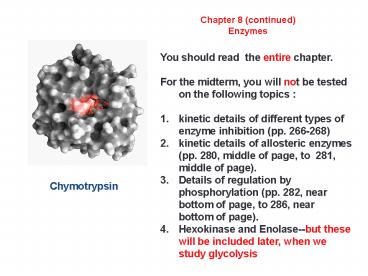Chapter 8 (continued) PowerPoint PPT Presentation
1 / 30
Title: Chapter 8 (continued)
1
Chapter 8 (continued) Enzymes
- You should read the entire chapter.
- For the midterm, you will not be tested on the
following topics - kinetic details of different types of enzyme
inhibition (pp. 266-268) - kinetic details of allosteric enzymes (pp. 280,
middle of page, to 281, middle of page). - Details of regulation by phosphorylation (pp.
282, near bottom of page, to 286, near bottom of
page). - Hexokinase and Enolase--but these will be
included later, when we study glycolysis
Chymotrypsin
2
Enzyme Kinetics Michaelis-Menton Equation
VmaxS Vo ____________
KM S
KM S when Vo Vmax
_____
2
3
1 KM 1 ______
_______ ______ Vo VmaxS
Vmax
Double-Reciprocal or Lineweaver-Burk Plot
4
Vmax S Vo ____________
KM S
Vmax k2 Etotal This is true
only for this specific (rather simple) mechanism!
5
kcat or Turnover Numbers
Vmax kcat Etotal
More general
6
Catalytic efficiency, kcat/KmMeasures how the
enzyme performs when S is low The upper limit
for kcat/Km is the diffusion limit - the rate at
which E and S diffuse together
kcatEtotalS _________________ Km S
kcatEtotalS _________________ Km
Vo
when S is low
7
(No Transcript)
8
Many enzymes catalyze reactions with two or more
substrates
a. Mechanisms involving ternary complex
9
Steady-State Kinetics Can Help Determine Mechanism
10
Inhibitor (I) binds only to E, not to ES
Inhibitor (I) binds only to ES, not to E. This
is a hypothetical case that has never been
documented for a real enzyme, but which makes a
useful contrast to competitive inhibition
Enzyme Inhibition
Inhibitor (I) binds either to E and ES or to ES
alone.
11
Competitive Uncompetitive
Mixed Inhibition
Inhibition Inhibition
Kmchanges while Vmax does not
Km and Vmax both change
Km and Vmax both change
12
1 KM 1 ______
_______ ______ Vo VmaxS
Vmax
Double-Reciprocal or Lineweaver-Burk Plot
13
Irreversible Inhibition
(Irreversible)
diisopropylfluorophosphate
chymotrypsin
14
Enzyme Activity is Affected by pH
15
Structure of Chymotrypsin
16
(No Transcript)
17
(No Transcript)
18
(No Transcript)
19
(No Transcript)
20
(No Transcript)
21
Pre-steady state evidence for an acyl enzyme
intermediate
22
(No Transcript)
23
(No Transcript)
24
(No Transcript)
25
(No Transcript)
26
Regulatory Enzymes important in controlling
flux through metabolic pathways
27
Example of an allosteric regulatory enzyme
- Two views of aspartate transcarbamoylase
- 12 subunits 6 are catalytic and six are
regulatory - Regulatory subunits are shown in red and yellow
28
Regulation by Feedback Inhibition
Conversion of L-threonine to L-isoleucine
catalyzed by a sequence five enzymes,
E1-E5 L-isoleucine is an inhibitory allosteric
modulator of E1
29
2. Regulation by covalent modification
Most common
30
2. Regulation by Covalent Modification Proteoly
tic cleavage of zymogen

